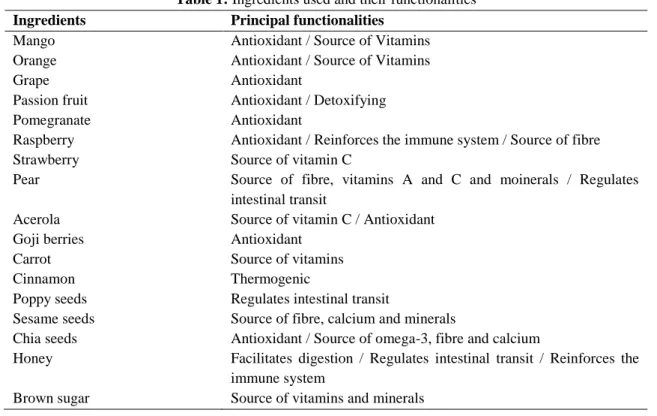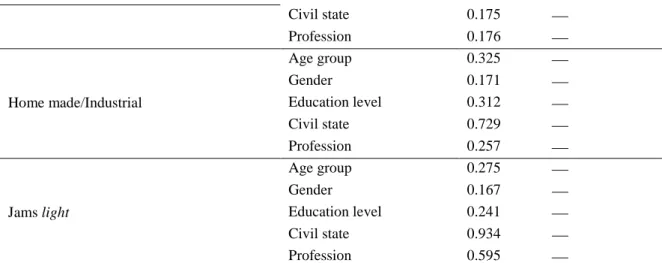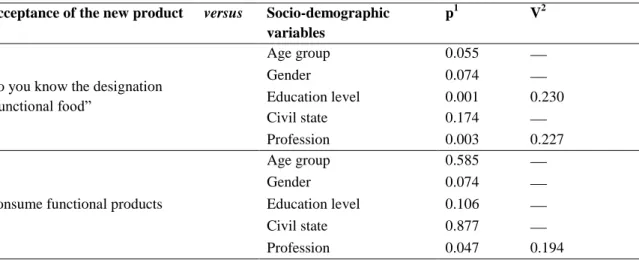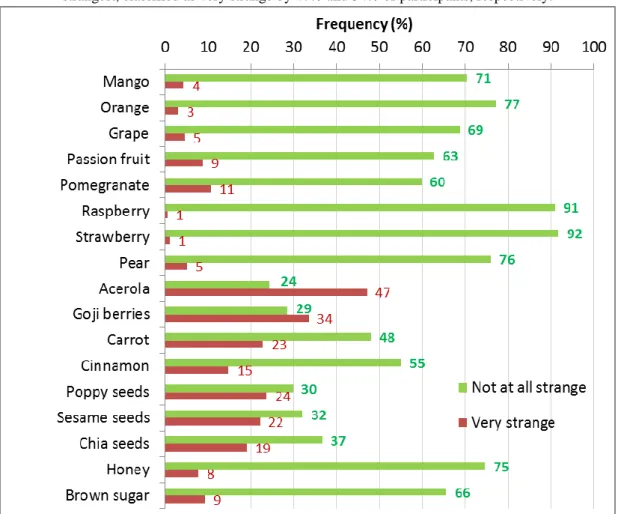Journal of Scientific and Engineering Research
285
Journal of Scientific and Engineering Research, 2018, 5(5):285-294
Research Article
ISSN: 2394-2630
CODEN(USA): JSERBR
Consumer Research on Innovative Jams Containing Ingredients with Potential Health
Benefits
Raquel P. F. Guiné
CI & DETS Research Centre/Dep. Food Industry-ESAV, Polytechnic Institute of Viseu, Portugal
AbstractConsumers are now more aware of the interconnection between the concepts of enjoyable foods and
foods with beneficial health properties, so that the market of foods more linked to health promotion has greatly expanded. In this work, the possible acceptance of the consumers towards innovative jams with the inclusion of functional ingredients was evaluated. For that, a questionnaire study was carried out on a sample of 400 participants during the period from November to December 2016. The questionnaires were applied in the central region of Portugal by direct interview after verbal informed consent and only to participants aged 18 years or over. The results obtained showed that 80% of the participants enjoy jams, 76% of them produce them at home and only 24% usually buy them. Most participants consume functional products (74%), and appreciate differently the various possible ingredients added in the jams, recognizing as particularly important the raspberry, strawberry, orange, pear, mango and honey, also recognizing as important the seeds (chia, poppy, sesame). Regarding the introduction of the ingredients in jams, those that caused more strangeness, due to their originality in this type of food, were acerola, goji berries or seeds. In conclusion, the study showed that selling jams with functional ingredients may be a good strategy, but it is important to carry out sensory tests to verify the acceptance of the products towards the type of ingredients used.
KeywordsFunctional ingredient, health benefit, new product development, market study, consumer acceptance
1. Introduction
New Product Development (NPD) has been gaining increasing importance in companies due to high competition and consumer demands, contributing to raise standards of excellence, quality, price and development time. However, the NPD is a complex and multidisciplinary process that requires a close relationship between the company's management, the Research and Development (R&D) team and the sectors of marketing, production, purchasing, quality control, sales, consumer and supplies. The development of new products allows the industry to adapt, diversify and even rejuvenate or reinvent itself so that it can adapt to changing technology and market conditions [1, 2].
Food and nutrition are basic requirements for the promotion and protection of health, enabling the full affirmation of the potential for human growth and development, with quality of life and citizenship. The promotion of healthy lifestyles coupled with proper dietary practices establishes a strategy of vital importance to address the eating and nutritional problems of the general population. Functional foods contain an additional health benefit besides their traditional nutritional value. The main reason leading consumers to buy functional foods is the growing desire to use foods to help prevent chronic diseases such as cardiovascular disease, Alzheimer's disease and osteoporosis, or to optimize health, for example by increasing energy, immune system or promoting general well-being [3, 4].
The food market is highly competitive, so it is often not enough to just get an idea of a new product and develop it, it is also necessary to sell it. Marketing can play a key role in the success of launching new products to the market, so companies must invest in marketing planning. In new product development projects there are a
Journal of Scientific and Engineering Research
286
number of steps to follow in order to design, develop and market a new product. The commercializationof new products is one of the risk factors that will influence the final results obtained. However, the degree of novelty of a new product may be high for marketing, irrespective of the type of market for which it is intended [5]. The objective of this work was to carry out a market research aimed at evaluating the potential acceptance of the consumers in relation to jams developed with the introduction of ingredients with beneficial properties for health.
2. Materials and methods 2.1. Products
Various jams were developed for commercialization, and included different combinations of the ingredients with beneficial health properties as indicated in Table 1.
Table 1: Ingredients used and their functionalities
Ingredients Principal functionalities
Mango Antioxidant / Source of Vitamins
Orange Antioxidant / Source of Vitamins
Grape Antioxidant
Passion fruit Antioxidant / Detoxifying
Pomegranate Antioxidant
Raspberry Antioxidant / Reinforces the immune system / Source of fibre
Strawberry Source of vitamin C
Pear Source of fibre, vitamins A and C and moinerals / Regulates
intestinal transit
Acerola Source of vitamin C / Antioxidant
Goji berries Antioxidant
Carrot Source of vitamins
Cinnamon Thermogenic
Poppy seeds Regulates intestinal transit
Sesame seeds Source of fibre, calcium and minerals
Chia seeds Antioxidant / Source of omega-3, fibre and calcium
Honey Facilitates digestion / Regulates intestinal transit / Reinforces the immune system
Brown sugar Source of vitamins and minerals
2.2. Instrument
The questionnaire developed included different parts to collect information on several issues of interest to the research: Part I - Socio-demographic data; Part II - Consumption habits relating to jams; Part III - Acceptance of the new product; Part IV - Attitudes to Functional Ingredients for Jams.
A questionnaire study was conducted on a sample of 400 participants during the period from November to December 2016. The questionnaires were applied in the central region of Portugal by direct interview after informed verbal consent and only to participants aged 18 years or over. All ethical questions were verified in the formulation and application of the questionnaire.
2.2. Data analysis
For the analysis of the data, several basic descriptive statistical tools were used. Contingency tables and the chi-square test were also used to evaluate the relationships between some of the variables under study. The level of significance considered was 5% in all cases. Cramer's V coefficient was used in some cases to assess the strength of significant relationships found among some of the variables in the study. This coefficient varies between 0 and 1, and for V 0.1 the association is considered weak, for V 0.3, the association is moderate and for V 0.5 or higher, the association is strong[6]. For all data analyses, the IBM SPSS software (version 24) was used.
Journal of Scientific and Engineering Research
287 3. Results and Discussion
3.1. Sample characterization
In this survey 400 participants were interviewed with a minimum age of 18 years and a maximum of 85 years, averaging 33 ± 15 years. Age was very similar for women and men, with mean values of 33 ± 15 years for women and 32 ± 15 years for men. The participants were classified according to their age in young adults (18 idade 30), who represented 56.5%, intermediate adults (31 age 50), corresponding to 29.3%, senior adults (51 age 65), representing 11.3% and, finally, the elderly (age 66), which accounted for only 3% of the sample.
Regarding gender, 67.3% were female versus a lower proportion of men (32.8%).
Considering the level of education, only a few had the lowest level of education, 6.0% for basic education - 1st cycle (4 years), 5.3% for primary education - 2nd cycle (6 years) . It followed the basic education - 3rd cycle (9 years) with 12.8% of the participants. The vast majority of the participants, 47.3%, had completed secondary education (12 years). Finally, 4.5% had completed the CET level (technological specialization course) and 24.3% had higher education (bachelor's degree, at least).
Regarding marital status, 60.3% of the participants were single, 29.9% were married or living together, 4.8% were divorced or separated and 5.0% were widowers.
In terms of professional activity, 46.3% were students, 12.1% were workers for the state, 22.2% were employed for private companies, 2.0% had a liberal profession, 5.3% were businessmen, 7.3% were unemployed and 4.8% had another situation not included in the previous ones.
3.2. Consumption habits relative to jams
Regarding the consumption habits, in the question about the taste for jams, it is verified that in the sample under study 80% like jams, but when comparing the genders it is verified that the women appreciate more this type of product, a group in which the percentage increases to 85%.
Regarding the regularity of consumption, 43% of the participants consume jams regularly, and the women who do so are 47% against only 36% of men. Figure 1 shows the frequency of consumption of jams for all respondents, as well as women and men separately. It is verified that 1/3 of the participants consume jams daily, being this also the percentage of women who do it every day, and in the case of the men the majority (33%) consume jams sporadically.
Figure 1: Frequency of consumption of jams
Concerning the composition of the jam, 56% prefer jams with only one flavour, 12% prefer flavour mixing and 32% do not have preference, also valuing both varieties. It was further found that these results were very similar for both genders. Regarding consistency, while 67% like creamy or pulp jams, the jams with pieces are enjoyed by only 50% of the participants.
Journal of Scientific and Engineering Research
288
It was also evaluated the situations in which the participants consumed jams, and the results showed that in this respect men and women presented great similarities, being the most frequent responses the consumption of jams on bread or on toast and biscuits (Figure 2). Also regarding the time of the day in which the consumption of jams takes place, the results obtained for women and men are similar (Figure 3), with breakfast and intervals between meals (morning and afternoon breaks) as preferred occasions for their consumption.
Figure 2: Ways of consumption of jams
Figure 3: Occasions for consumption of jams
Regarding the preference for home-made or purchased jams, 76% of the participants prefer home-made jams, 78% for women and 69% for men.
When asked if they usually consume low-sugar jams, 55% of the participants answered affirmatively, with these percentages being 59% and 47%, respectively for women and men. This indicates that women are more interested in light products, possibly due to aesthetic issues.
Table 2 shows the main associations investigated between variables related to questions formulated about consumption habits and socio-demographic variables, using the chi-square test and its Cramer coefficient (V), which measures the strength of the association. It is verified that liking jams is significantly associated with almost all socio-demographic variables considered, at a significance level of 5%, except for the age group.
Journal of Scientific and Engineering Research
289
However, in general, the associations are weak, considering the low values of Cramer's V (V < 0.2), and in the case of the variables profession and qualifications the associations already tend to moderate (V > 0.2). The results show that regular consumption of jams is significantly associated, although with a weak association, to the age group and marital status, being still moderately associated to the profession. Regarding the frequency of consumption, it is found that this is significantly associated with all variables considered except gender, although the nature of the associations is slightly different, being weak in the case of civil status and moderate in the other cases. In relation to all other variables considered in relation to consumption habits, they are not associated with any of the socio-demographic variables considered, except for the association between the creamy or pulp consistency of the jams and the age group, which is significant and with a value of V indicating a moderate association.
Table 2: Associations between the consumption habits and the socio-demographic variables
Consumption habits versus Socio-demographic
variables p1 V2 Likes jams Age group 0.063 Gender 0.000 0.175 Education level 0.000 0.251 Civil state 0.041 0.144 Profession 0.006 0.214
Consumes jams regularly
Age group 0.013 0.167 Gender 0.051 Education level 0.159 Civil state 0.027 0.154 Profession 0.005 0.220 Frequency of consumption Age group 0.003 0.213 Gender 0.946 Education level 0.013 0.232 Civil state 0.039 0.179 Profession 0.001 0.275
Composition of the jams
Age group 0.222
Gender 0.295
Education level 0.469
Civil state 0.991
Profession 0.162
Consistency (creamy or pulpy)
Age group 0,046 0.210
Gender 0.094
Education level 0.509
Civil state 0.396
Profession 0.145
Consistency with pieces
Age group 0.401 Gender 0.905 Education level 0.326 Civil state 0.122 Profession 0.298 Consumption in bread Age group 0.057 Gender 0.958 Education level 0.202
Journal of Scientific and Engineering Research 290 Civil state 0.175 Profession 0.176 Home made/Industrial Age group 0.325 Gender 0.171 Education level 0.312 Civil state 0.729 Profession 0.257 Jams light Age group 0.275 Gender 0.167 Education level 0.241 Civil state 0.934 Profession 0.595
1Significance of the chi-square test; 2Cramer´s association coefficient: presented only in the cases in which the
association is significant at the significance level considered (p < 0.05).
3.3. Acceptance of the new product
When questioned whether they are familiar with the term "functional food," only 44% of the respondents answered affirmatively, with this percentage slightly increasing to 47% for women and decreasing to 38% for men.
It was found that 93% of the respondents associate functional foods with foods with health benefits, with this tendency common to both genders (96% and 89%, respectively for men and women). When questioned whether functional foods are considered to be fashionable dietary trends, only 8% of respondents answered in the affirmative, with a slight difference between genders (6% of women and 13% of men consider functional foods to be a fashion).
From the participants in this study, 67% stated that they consume functional foods, and the percentage of women who do so is significantly higher than men (71% and 60%, respectively). Figure 4 shows the types of functional foods consumed by the participants in the survey, and reveals that yoghurt is widely consumed by both men and women, followed by juices (most preferred by men: 47% versus 37 %) and shakes (these are more preferred by women: 40% vs. 32%).
Journal of Scientific and Engineering Research
291
When asked if they would be potential consumers of functional jams, 77% of respondents said yes, with women being more open to this possibility than men (80% and 71%, respectively).
Regarding the attributes that potential consumers would like to find in a functional jam, the reduced sugar content appears first (86% overall and 75% and 82% respectively for women and men) (Figure 5). Other valued attributes include antioxidant properties, high fibre content and source of vitamins and minerals, respectively with 64%, 53% and 52% of affirmative responses when considering the globality of the participants in the study.
Figure 5: Characteristics valued in functional jams
Table 3 presents the main associations investigated between variables related to the questions formulated about acceptance of the new product and socio-demographic variables, using the chi-square test and its Cramer coefficient (V), which measures the strength of the association. The results indicate that in most cases the acceptance behaviour of the new product is not significantly associated with the socio-demographic variables considered, except for the knowledge about what is a functional food, moderately associated to the qualifications and the profession, and still the consumption of functional products, which is significantly associated with the profession, albeit weakly. Thus, it can be concluded that knowledge about functional products is influenced by both the level of education and the professional activity of the participants.
Table 3: Associations between acceptance of the new product and sociodemographic variables
Acceptance of the new product versus Socio-demographic
variables
p1 V2
Do you know the designation “functional food” Age group 0.055 Gender 0.074 Education level 0.001 0.230 Civil state 0.174 Profession 0.003 0.227
Consume functional products
Age group 0.585
Gender 0.074
Education level 0.106
Civil state 0.877
Journal of Scientific and Engineering Research
292
Would de a consumer of functional jams
Age group 0.167 Gender 0.077 Education level 0.160 Civil state 0.378 Profession 0.428 1
Significance of the chi-square test; 2Cramer´s association coefficient: presented only in the cases in which the association is significant at the significance level considered (p < 0.05).
3.4. Attitudes regarding the functions ingredients tested
Figure 6 shows the average classifications attributed to the different ingredients used to make the jams, on a scale from 1 (not important) to 5 (very important), given their potential health benefits. It was verified that the ingredients classified with higher values, and therefore indicated by the participants as more important, were raspberry (classification of 4.4), followed by strawberry (4.3), orange (4.2), mango, pear and honey (4.1 for all three) and also with a rating of 4.0 passion fruit, grape and pomegranate. At the other extreme is acerola, with the lowest classification of 3.5 followed by the goji berries (3.6).
Figure 6: Importance attributed to the functional ingredients incorporated in the jams
Figure 7 shows the way in which the participants consider the different ingredients strange in the context of jams, and the results show that both strawberries and raspberries are not considered strange at all by the vast majority of participants (92% and 91%, respectively), while acerola and goji berries were considered the
Journal of Scientific and Engineering Research
293
strangest, classified as very strange by 47% and 34% of participants, respectively.
Figure 7: Opinion about the originality of the ingredients used in the jams
4. Conclusions
The results obtained in this work indicate that jams constitute a potential market for the development of products that include ingredients with health benefits, since they are consumed by the majority of people and with a high frequency. With regard to the possible acceptance of this type of products, there is a consumer market for functional foods in general, and in particular for functional jams. Regarding the alternative ingredients used, there is still a distrust toward some, such as acerola or goji berries, with consumers showing better acceptability for fruits and alternative sweeteners, such as honey or brown sugar, instead of refined sugars.
Acknowledgements
Thanks to the students from Food Quality and Nutrition at ESAV: Diogo Martins, Sónia André, Vera André, Catarina Castro, Mélanie Rodrigues
References
[1]. Senhoras EM, Takeuchi KP, Takeuchi KP (2007) Gestão da Inovação no Desenvolvimento de Novos Produtos. In: Proceedings. Rio de Janeiro, Brazil, pp 1–15
[2]. Dissa AO, Bathiebo DJ, Desmorieux H, et al (2011) Experimental characterisation and modelling of thin layer direct solar drying of Amelie and Brooks mangoes. Energy 36:2517–2527. doi: 10.1016/j.energy.2011.01.044
[3]. Khan RS, Grigor J, Winger R, Win A (2013) Functional food product development – Opportunities and challenges for food manufacturers. Trends in Food Science & Technology 30:27–37. doi: 10.1016/j.tifs.2012.11.004
Journal of Scientific and Engineering Research
294
[4]. Maeda-Yamamoto M Development of functional agricultural products and use of a new health claim system in Japan. Trends in Food Science & Technology. doi: 10.1016/j.tifs.2017.08.011
[5]. Madeira FGP da S (2015) Inovação e lançamento de novos produtos no mercado alimentar : plano de marketing para o lançamento de um novo produto da marca Maggi da Nestlé Portugal. MasterThesis, Instituto Superior de Economia e Gestão







